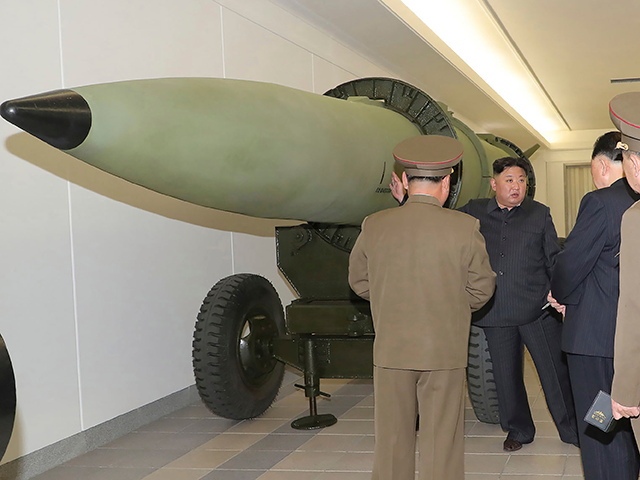Satellite images published by the monitor site 38 North this weekend indicate that communist North Korea has “refurbished” the uranium enrichment facility at its Yongbyon Nuclear Scientific Research Center and is potentially expanding the operation of its nuclear reactors there.
The director of 38 North, Jenny Town, said at a press conference on Monday that the group does not believe that the “high level” of activity at Yongbyon will translate to an imminent nuclear weapons test, as the site for that sort of action, the Punggye-ri Nuclear Test Site, does not appear prepared for a bomb test. Nonetheless, evidence of expanding its ability to enrich uranium suggests that the North Korean government is seeking to increase its supply of radioactive materials usable to build more nuclear weapons.
The activity documented is consistent with public statements by communist dictator Kim Jong-un in the past six months, particularly his call in late December for “an exponential increase of the country’s nuclear arsenal.” On Sunday, North Korea’s state media arm, the Korean Central News Agency (KCNA), threatened to use nuclear weapons against America and South Korea in response to ongoing joint military exercises by the two countries.
The site 38 North uses satellite images to keep track of nuclear and other activity within notoriously secretive North Korea, amassing years of images that can be used to assess the building and development of the country generally. The images published of Yongbyon on Saturday appeared to show, experts said, that Yongbyon’s Experimental Light Water Reactor (ELWR) may be enduring functionality tests and that the government had reconstructed and built several facilities, including a new administrative building.
“Recent commercial satellite imagery of North Korea’s Yongbyon Nuclear Scientific Research Center indicates a high level of activity around the complex,” 38 North relayed. “The 5 MWe Reactor continues to operate, and construction has started on an additional support building around the Experimental Light Water Reactor (ELWR). Furthermore, water discharges have been detected that could be associated with testing of the ELWR’s cooling system.”
The ELWR is likely not finally functional, the site’s experts said, adding the caveat that “only an onsite inspection can confirm the function of the actual cooling arrangements.” The water around the facility did indicate, however, that complex workers were attempting to test or use the reactor.
Near the Uranium enrichment plant, 38 North documented “construction and refurbishment activity,” including the replacement of a roof over a nearby building of unclear use. Some of the buildings restored, the site claimed, were likely offices for administrating the site or research laboratories. Indications that the site needs more offices suggest that the government intends to expand its ability to enrich uranium.
Town, the head of 38 North, clarified on Monday that increased enrichment capacity did not necessarily mean Pyongyang would soon test a bomb. Town suggested that testing would not make sense to do after Kim announced mass production of nuclear weapons, as the objective of testing is to ensure that the model works before mass producing it.
“I would note that Kim Jong-un has recently talked about going into mass production of nuclear warheads. And so I think it would be very out of character for a test to be done now when they’re already talking about mass production,” the South Korean news agency Yonhap reported.
Town added that the Punggye-ri Nuclear Test Site did not show any “notable” activity in recent months. North Korea has conducted all six of its known nuclear weapons tests at Punggye-ri, located on the northern Mount Mantap. Its last test occurred in 2017 and led many experts to speculate that the site was unusable due to the extensive damage of the past six tests. In 2018, the communist government staged a dramatic ceremony to declare the site permanently closed, offering unprecedented invites to foreign journalists to come view its “demolition.” The “demolition” consisted only of small explosions at the entrance of the nuclear test site, however, and Pyongyang did not allow journalists or other international observers to investigate the site.
South Korean media have on multiple occasions reported activity at Punggye-ri that indicated a rehabilitation of the site, most recently almost exactly a year ago, but no public information suggests any meaningful activity has occurred at the site since the last nuclear test occurred there.
North Korea significantly slowed down its nuclear activities during the tenure of President Donald Trump, who visited the country and met with Kim Jong-un on several occasions. Under current leftist President Joe Biden, who has not prioritized North Korea policy in his administration, Kim outlawed denuclearization – which he committed to under Trump – and ended 2022 with a call to greatly increase his country’s nuclear weapons supply.
“Now that the south [sic] Korean puppet forces who designated the DPRK [North Korea] as their ‘principal army’ and openly trumpet about ‘preparations for war’ have assumed our undoubted enemy,” Kim said in late December, “it highlights the importance and necessity of a mass-producing of tactical nuclear weapons and calls for an exponential increase of the country’s nuclear arsenal.”
“Stressing the importance of bolstering the nuclear force, the report made clear that our nuclear force considers it as the first mission to deter war and safeguard peace and stability,” Kim concluded, according to KCNA.
Kim publicly debuted an alleged new model of intercontinental ballistic missile (ICBM), the Hwasong-17, at a parade in February. His government threatened to use its “nukes” against Seoul and Washington on Sunday.
“The U.S. and its followers should never forget the fact that their rival state has possessed the nuclear attack capability in practice as well as the characteristics of the people and army of the DPRK which do not make empty talk,” KCNA declared on Sunday. “It will be quite clear how the DPRK’s nukes will be used if the war deterrence does not work on those who are running amuck, not being afraid of nuclear weapons.”

COMMENTS
Please let us know if you're having issues with commenting.